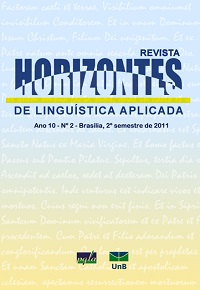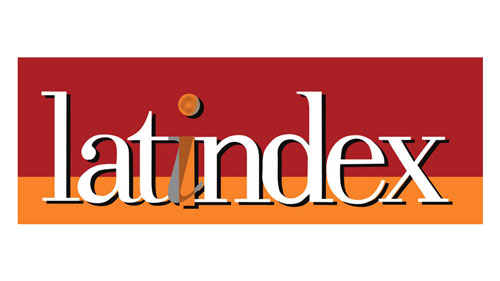Estímulos corretivos, compreensão do estímulo corretivo, produção modificada e reparo para aprendizes de l2 com ansiedade de língua estrangeira
DOI :
https://doi.org/10.26512/rhla.v10i2.1077Mots-clés :
Feedback corretivo oral;, Estímulos corretivos;, Reformulações corretivas;, Ansiedade;, ReparoRésumé
O objetivo deste estudo foi investigar o efeito de estímulos corretivos em aprendizes com alto e baixo nível de ansiedade. Tem sido sugerido pelas pesquisas da área que reformulações corretivas afetaram negativamente os aprendizes com alta ansiedade. Este tem sido um ponto de discórdia no debate, se a correção gramatical oral negativa explícita é útil na aquisição de L2. Dado que a ansiedade em Planos Educacionais Individuais (PIE) tornou-se cada vez mais comum, o argumento contra feedback na correção oral (FCO) merece atenção. É notória a carência de pesquisas que investiguem os efeitos de negociação da forma relacionada com a ansiedade. Este trabalho se enquadra nessa linha de reformulações corretivas. Para este estudo foram formados quatro grupos: aprendizes com alta ansiedade, frente a estímulos corretivos; aprendizes com baixa ansiedade no mesmo contexto; aprendizes com alta ansiedade frente a reformulações corretivas, e alunos de baixa ansiedade respectivamente. Os resultados do estudo confirmaram que as reformulações corretivas são de fato prejudiciais para o sucesso de alunos com alta ansiedade. De forma mais positiva, o presente estudo também mostrou que os aprendizes com alta ansiedade superaram todos os outros grupos, quando administrados pelo feedback corretivo por meio de estímulos corretivos. Isto pode ser devido à s taxas aumentadas de uptake, modificações e reparo.Os resultados também concordam com a pesquisa contemporânea de que o feedback por meio de estímulos corretivos geralmente é benéfica para a maioria dos aprendizes.
Téléchargements
Références
EGI, Takako. Uptake, modified output, and learner perceptions of recasts: learner responses as language awareness. The Modern Language Journal, v. 94, n. 1, p. 1-21, 2010. doi:10.1111/j.1540-4781.2009.00980.x.
ELLIS, Rod. Variability and the natural order hypothesis. In R. Barasch; C. Vaughan James (Eds.). Beyond the monitor model. Boston: Heinle and Heinle, 1993.
DUFF, PatriciaA. An ethnography of communication in immersion classrooms in Hungary. TESOL Quarterly, v. 29, n. 3, p. 505-537, 1995.
FARRAR, Michael J. Discourse and the acquisition of grammatical morphemes. Journal of Child Language, v. 17, n. 3, p. 607-624, 1990.
FARRAR, Michael J. Negative evidence and grammatical morpheme acquisition . Developmental Psychology, v. 28, n. 1, p. 90-98, 1992.
HORWITZ, Elaine K.; HORWITZ, Michael B.; COPE Joann. Foreign language classroom anxiety. The Modern Language Journal, v. 70, n. 1, p. 125-132, 1986.
KRASHEN, StephenD. Second language acquisition andsecond language learning. Language teaching methodology series. Oxford: Pergamon Press, 1981.
LOCHTMAN, Katja. Oral corrective feedback in the foreign language classroom: how it affects interactionin analytic foreign language teaching. International Journal of Educational Research, v. 37, n. 3/4, p. 271-283, 2002. doi:10.1016/S0883-0355(03)00005-3.
LONG, Michael; INAGAKI, Shunji; ORTEGA, Lourdes.The role of implicit negative feedback in SLA: models and recasts in Japanese and Spanish. The Modern Language Journal, v. 82, n. 3, p. 357-371, 1998.
LYSTER, Roy. Negotiation of form, recasts, and explicit correction in relation to error types and learner repair in immersion classrooms. Language Learning, v. 48, n. 2, p. 183-218, 1998.
LYSTER, Roy. Negotiation in immersion teacher-student interaction. International Journal of Educational Research, v. 37, n. 3/4, p. 237-253, 2002. doi:10.1016/S0883-0355(03)00003-X
LYSTER, Roy; IZQUIERDO, Jesus. Prompts versus recasts in dyadic interaction. Language Learning, v. 59, n. 2, p. 453-498, 2009. doi:10.1111/j.1467-9922.2009.00512.x
LYSTER, Roy; RANTA, Leila. Corrective feedback and learner uptake: negotiation of form in communicative classrooms. Studies in Second Language Acquisition, v. 19, n. 1, p. 37-66, 1997.
LYSTER, Roy; SAITO, Kazuya. Oral feedback in SLA. Studies in Second Language Acquisition, v. 32, n. 2, p. 265-302, 2010.
PINKER, Steven. Learnability and cognition: the acquisition of argument structure. Cambridge, MA: MIT Press, 1989.
SCHMIDT,RichardW.;FROTA, SilviaN. Developing basic conversational ability in a second language:a case study of an adult learner of Portuguese. In DAY, RichardR. (Ed.).Talking to learn: Conversation insecond language acquisition. Rowley, MA: NewburyHouse, 1986. p. 237-326.
SKINNER, BurhussF. The behavior of organisms. New York: Appleton-Century, 1938.
SHEEN, Younghee.Recasts, language anxiety, modified output, and L2 learning. Language Learning, v. 58, n. 4, p. 835-874, 2008. doi:10.1111/j.1467-9922.2008.00480.x.
TRUSCOTT, John. What's wrong with oral grammar correction. Canadian ModernLanguage Review, v. 55, n. 4, p. 437-456, 1999.
WALKER, Constance L.; TEDICK, Diane J. The complexity ofimmersion education: teachers address the issues. The Modern Language Journal, v. 84, n.1, p. 5-27, 2000.
Téléchargements
Publié-e
Comment citer
Numéro
Rubrique
Licence

A Revista Horizontes de Linguística Aplicada de http://seer.bce.unb.br/index.php/horizontesla/index é licenciado sob uma Licença Creative Commons Atribuição-Uso não-comercial-Vedada a criação de obras derivadas 3.0 Unported.
- Autores mantém os direitos autorais e concedem à revista o direito de primeira publicação, sendo o trabalho simultaneamente licenciado sob a Creative Commons Attribution License o que permite o compartilhamento do trabalho com reconhecimento da autoria do trabalho e publicação inicial nesta revista.
- Autores têm autorização para assumir contratos adicionais separadamente, para distribuição não-exclusiva da versão do trabalho publicada nesta revista (ex.: publicar em repositório institucional ou como capítulo de livro), com reconhecimento de autoria e publicação inicial nesta revista.





